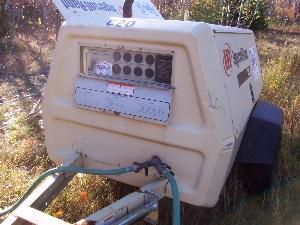
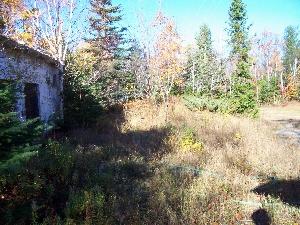
*Jackhammer Operation*
Rubies tend to be "do it yourself" type people. Odds are if a Rubie needs to drill in to rock or ledge they would rent a jackhammer and do it themselves rather than pay somebody else. We are getting ready to put up a 190' Rohn 65 tower on a ledge faced mountain, therefore the base pin and anchor points must be in ledge. The anchor points will be 3 feet deep minimum. The 20' sections are 330 pounds each and the 10' sections are 180. The anchors have to be solid.
NOTE: Eye and ear protection is a MUST when using a jackhammer. They are loud and when blowing down the hole, rock fragments come flying out.
Contrary to what you've seen in the cartoons of a jackhammer acting like a pogo-stick and the operator bouncing all over the place, that's not the case. It'll bounce around a little and the bit will try to walk some until it gets started in to the rock and then it's not bad at all. Drilling rock is like drilling metal. The bit will walk until it decides where it wants to be.
Here's how a jackhammer works:


Compressor-------------------------------------Hose run to drilling location
The air compressor is powered by a diesel engine and maintains 100 PSI with the jackhammer running.
Around here the "rentee" has to buy the bit for the hammer. The one I"m holding costs $110 and a 4' long shaft is well over $100. The shafts are supplied, but if they break or are lost the customer has to pay for it. The bit simply screws on to the shaft.
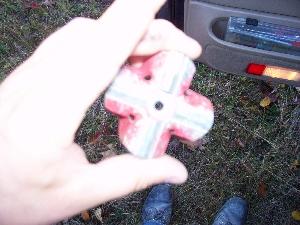
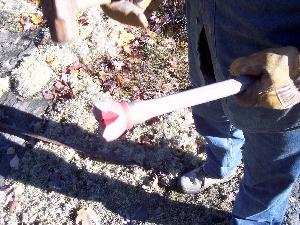
Bit------------------------------------Bit on shaft
The shaft is hollow and the bit has 5 holes in it. This is so that the hole can be blown out to clear ledge fragments.
The bottom of the jackhammer has a latch gate to hold the shaft. Insert it and close the gate.
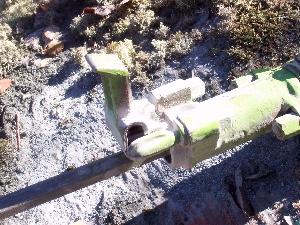
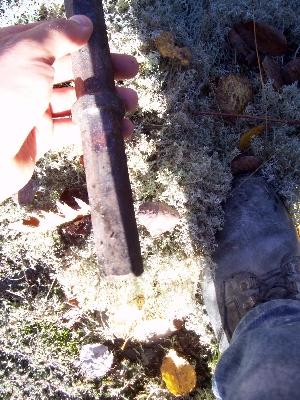
Latch gate-------------------top of shaft
When we drill for anchor points we go in at an angle pointing toward the tower base so that the galvanized rod isn't stressed sideways.
To drill at an angle:
Tip- This set up comes with a 2' and 4' shaft. Use the shorter shaft and drill down 2" and then change to the longer shaft and keep going. It's much easier to control.
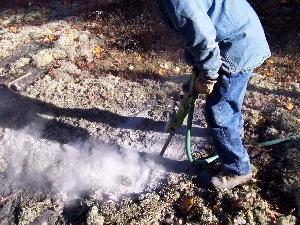
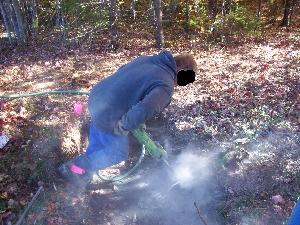
Drilling with a 2' shaft- notice the angle
The white cloud is ledge dust
The jackhammer has two controls. One is the main air valve and the other selects between blow down and "bounce you up and down".
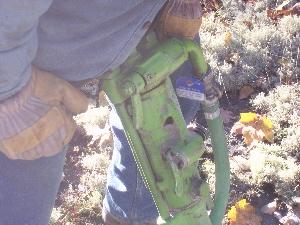
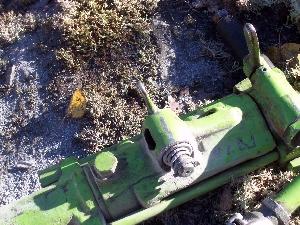
The hole under the lower valve is the air exhaust port
NOTE: If you're drilling and the hammer starts stalling meaning the shaft has difficulty turning for no obvious reason it probably is a lubrication problem. Put a few drops of motor oil in the air connect and then remove the plug below the selector valve and add oil.
The top lever turns the air on and off. Horizontal is off, facing down is on. The bottom one when facing down turns the jackhammer on. When it's horizontal it turns the jackhammer off, but allows 100 PSI of air to go down through the shaft and blow the fragments out of the hole.
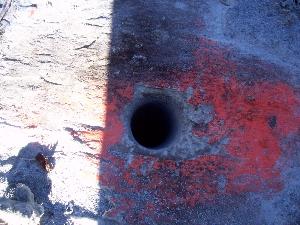
A nice hole
Today we had a slight problem. The brand new bit and a 4' shaft got ruined. The threads on the shaft broke while drilling. We managed to recover the FUBAR'd bit so the hole can still be used. We'll find out who's really responsible for the rental company's shaft breaking. We think they should be. So when you get frustrated because it's a Sunday morning with no rental places open and you're on top of a mountain with no extra bits (rental place was out of them) things tend to get aggravating...as you can see.
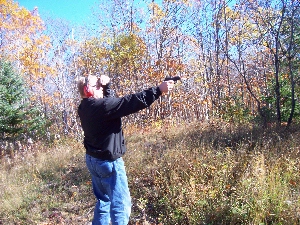
Venting some frustration
If you stand on a jackhammer for any length of time, say just drilling 4, 4' deep holes, don't be surprised if your wrists are sore the next day. If you have a lot of drilling to do, I recommend having 2-3 and keep swapping off.
Jaden
www.alpharubicon.com
All materials at this site not otherwise credited are Copyright © 1996 - 2007 Trip Williams. All rights reserved. May be reproduced for personal use only. Use of any material contained herein is subject to stated terms or written permission.